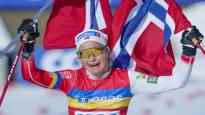Therese Johaug’s graduation news came to a challenging place for the Norwegian Ski Association. In Finland, success expectations for next season are considerably more modest compared to previous seasons.
Norwegian women’s skiing has lived in recent years Therese Johaugin success more than ever.
Johaug, 33, who finished his career on Saturday, competed in the World Cup’s regular trips this season with just six starts, four of which he won.
Although behind Johaug Heidi Weng and Maiken Caspersen Falla have both been able to win one race in the World Cup, meaning that the number of Norwegian winners is the same as in the post-doping regiment of Johaugin 2018-2019, the volume is now quite different from three years ago.
At that time, nine Cup victories were recorded in Johaug’s name, Ingvild Flugstad Östbergin four and Falla three. 31-year-old Östberg and Falla have since suffered from problems and have not been able to get through the balance.
After the same has been established behind Johaug’s position as the number one skier in Weng, 30, which has been at the forefront for years, the sharpest tip in Norwegian women’s skiing has become considerably blunted.
As the statistics below show, especially during women’s normal trips, Norway has had difficulty getting the athletes in the top six in addition to Johaug. The only flashes of light have been free-racing races, of which, for example, the interim start in Lillehammer was familiar Norway – five skiers in the top 10.
Otherwise, the team contribution has often been even worse than in Finland. For example, in the World Cup, Finland has made two skiers in the top six in five races, but Norway only Four times.
Of course, Johaug won all three personal normal trips at the Beijing Olympics, and even in sprinting, the best Norwegian was better than the best Finn, but if the second best skiers in the countries on those trips are taken as a benchmark, Finland took the victory 3–1. Finland was also better in both women’s messages, although it did not receive any medals.
Although the results in the Cup have been poor, reflecting Norway’s skiing history, Beijing’s performance was astounding: behind Johaug, the second best Norwegian was 13th in the 30-kilometer race, 18th in the combined race and 21st in the two-time start in Finland.
– We are at a turning point for the women’s national team. This season Mathilde Myhrvold and Tiril Udnes Weng have taken steps in the right direction. I believe they can be successful in a couple of years, as the head coach of the Norwegian cross-country team in 2016-2018 Tor Arne Hetland evaluates Sport during the Beijing Olympics.
23-year-old Myhrvold and 25-year-old Tiril Udnes Weng have achieved the first personal podium finish of their careers in the World Cup this season, but in the Olympic sprint, Myhrvold’s road was already broken in the semi-finals and Weng’s semi-finals.
The Olympic finals were skied without a Norwegian representation for the first time since 2006 – the same time last time at the World Championships in 2009.
At the Youth World Championships in Lygna, Norway, after the Beijing Olympics, Norwegian promises made a strong case in the women’s under-20s series. Maria Hartz Mellingin in addition to sprint gold, Norwegian women returned as winners in the post since 2019. Also Emma Kirkeberg Mörk and Tuva Anine Brusveen-Jensen achieved a personal medal.
However, Norway’s declining number of places in World Cup competitions is hampering young Norwegian women’s breakthroughs in the World Cup and thus in the championships.
Although in the Nations Cup, which measures superiority between countries, the top eight countries each receive a full six seats, the leaders of the World Cup and the Scandinavian Cup do not burden the quota, but their place in the World Cup competitions is personal.
However, as Johaug competed sparingly for the last few years and the level behind him was not the same, the so-called an extra place was out of the question for Norwegians. While the top spot in the Skandi Cup has not been constantly held by the Norwegians, the women of the fjord have sometimes had to cope in the World Cup, like other countries, with a quota of six athletes.
– The number of places in the World Cup is a challenge, but I believe that in the next few years we will see the emergence of a new generation. Right now, the situation is challenging. However, young people should not have a lack of motivating factors, Hetland said, referring above all to the World Championships in Trondheim in 2025.
